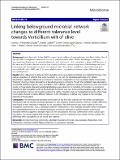Por favor, use este identificador para citar o enlazar a este item:
http://hdl.handle.net/10261/199415COMPARTIR / EXPORTAR:
 SHARE SHARE
 CORE
BASE CORE
BASE
|
|
| Visualizar otros formatos: MARC | Dublin Core | RDF | ORE | MODS | METS | DIDL | DATACITE | |

| Título: | Linking belowground microbial network changes to different tolerance level towards Verticillium wilt of olive |
Autor: | Fernández-González, Antonio José CSIC ORCID; Cardoni, Martina CSIC ORCID; Gómez-Lama Cabanás, Carmen CSIC; Valverde-Corredor, Antonio CSIC ORCID; Villadas, Pablo J. CSIC ORCID; Fernández-López, Manuel CSIC ORCID; Mercado-Blanco, Jesús CSIC ORCID | Palabras clave: | Microbial functional community Microbial structural community Olea europaea Rhizosphere Root endosphere Verticillium dahliae Disease tolerance Co-occurrence networks |
Fecha de publicación: | 1-feb-2020 | Editor: | BioMed Central | Citación: | Microbiome 8(1): 11 (2020) | Resumen: | [Background] Verticillium wilt of olive (VWO) is caused by the soilborne fungal pathogen Verticillium dahliae. One of the best VWO management measures is the use of tolerant/resistant olive cultivars. Knowledge on the olive-associated microbiome and its potential relationship with tolerance to biotic constraints is almost null. The aims of this work are (1) to describe the structure, functionality, and co-occurrence interactions of the belowground (root endosphere and rhizosphere) microbial communities of two olive cultivars qualified as tolerant (Frantoio) and susceptible (Picual) to VWO, and (2) to assess whether these communities contribute to their differential disease susceptibility level. [Results] Minor differences in alpha and beta diversities of root-associated microbiota were detected between olive cultivars regardless of whether they were inoculated or not with the defoliating pathotype of V. dahliae. Nevertheless, significant differences were found in taxonomic composition of non-inoculated plants’ communities, “Frantoio” showing a higher abundance of beneficial genera in contrast to “Picual” that exhibited major abundance of potential deleterious genera. Upon inoculation with V. dahliae, significant changes at taxonomic level were found mostly in Picual plants. Relevant topological alterations were observed in microbial communities’ co-occurrence interactions after inoculation, both at structural and functional level, and in the positive/negative edges ratio. In the root endosphere, Frantoio communities switched to highly connected and low modularized networks, while Picual communities showed a sharply different behavior. In the rhizosphere, V. dahliae only irrupted in the microbial networks of Picual plants. [Conclusions] The belowground microbial communities of the two olive cultivars are very similar and pathogen introduction did not provoke significant alterations in their structure and functionality. However, notable differences were found in their networks in response to the inoculation. This phenomenon was more evident in the root endosphere communities. Thus, a correlation between modifications in the microbial networks of this microhabitat and susceptibility/tolerance to a soilborne pathogen was found. Moreover, V. dahliae irruption in the Picual microbial networks suggests a stronger impact on the belowground microbial communities of this cultivar upon inoculation. Our results suggest that changes in the co-occurrence interactions may explain, at least partially, the differential VWO susceptibility of the tested olive cultivars. |
Versión del editor: | https://doi.org/10.1186/s40168-020-0787-2 | URI: | http://hdl.handle.net/10261/199415 | DOI: | 10.1186/s40168-020-0787-2 | E-ISSN: | 2049-2618 |
| Aparece en las colecciones: | (EEZ) Artículos (IAS) Artículos |
Ficheros en este ítem:
| Fichero | Descripción | Tamaño | Formato | |
|---|---|---|---|---|
| 40168_2020_Article_787.pdf | 3,96 MB | Adobe PDF |  Visualizar/Abrir |
CORE Recommender
PubMed Central
Citations
36
checked on 06-abr-2024
SCOPUSTM
Citations
74
checked on 15-abr-2024
WEB OF SCIENCETM
Citations
68
checked on 29-feb-2024
Page view(s)
218
checked on 18-abr-2024
Download(s)
160
checked on 18-abr-2024

